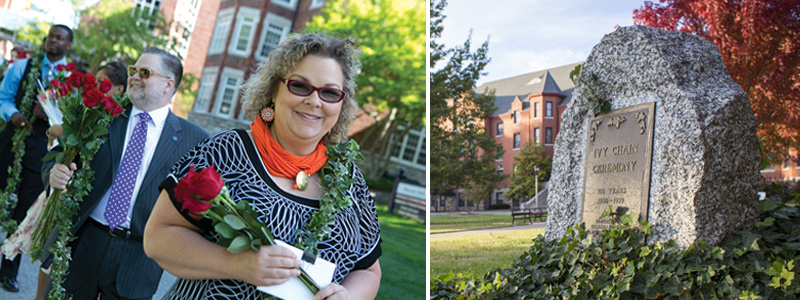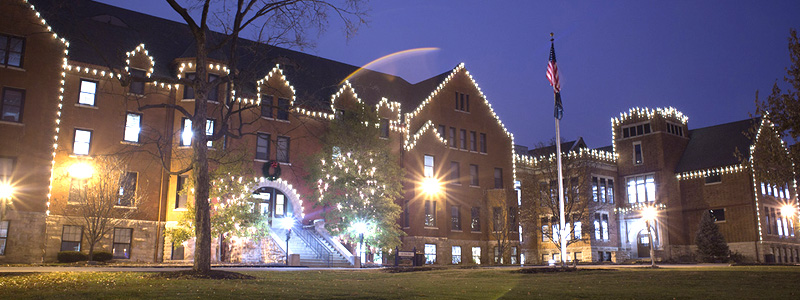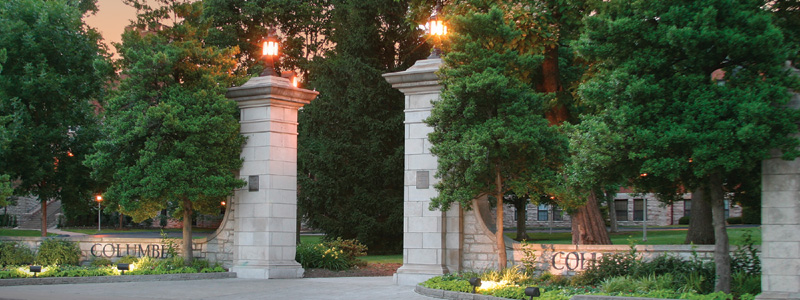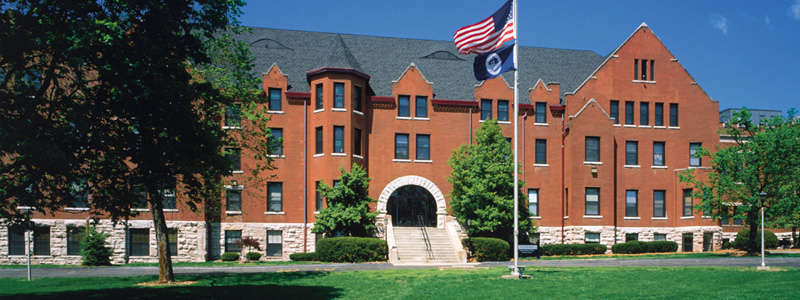College Traditions
Columbia College is steeped in time-honored traditions that students and alumni embrace from generation to generation.

Ivy Chain Ceremony
Columbia College’s Ivy Chain is one of the nation’s oldest continuously held commencement events. First held in 1900, it is the most traditional event of graduation weekend.
In the Ivy Chain Ceremony, associate, baccalaureate and master's degree candidates march from the Atkins-Holman Student Commons through Rogers Gates onto Bass Commons. Candidates then have an ivy chain draped over their shoulders, symbolizing the graduates' connection with the college and their fellow classmates.
Each participant also receives three long-stem red roses with notes to give to people who have made a significant impact on the Ivy Chain participant's college career. This further radiates the ceremony and the tradition.

Holiday Lighting Ceremony
Columbia College welcomes the holiday season with an annual holiday lighting ceremony on Bass Commons at the main campus in Columbia, Missouri. The ceremony, free and open to the public, consists of the lighting of more than 4,500 white lights that illuminate the exterior of the campus throughout the holiday season. The college president, along with the Student Government Association (SGA) president, leads a countdown. At zero, the lights burst into view (from west to east) on the peaks and gables of Hughes Hall, Launer Auditorium, St. Clair Hall, Dorsey Hall, Atkins-Holman Student Commons and Missouri Hall.
The lights are the brainchild of Bonnie Brouder, wife of the college's 16th president, Gerald Brouder. Mrs. Brouder came up with the idea in 1995 and first consulted the man who lights the Plaza in Kansas City, one of the nation’s premier holiday lighting shows. The lights now are permanently installed and represent one of the college’s endeared traditions.

Rogers Gate
In 1912, St. Clair Moss secured funds from trustees, alumnae and friends to erect a stone gateway entrance to the campus. Named as a memorial to Joseph K. Rogers (president 1858 - 1877), the immensely popular educator who carried Christian College through the Civil War, the gate stands as a testament to challenges faced and overcome. Seeing education as the only hope for America's future, Rogers' determination was unwavering. "I would rather die than see Christian College go down," he said.
Students who now "Storm the Gate" during orientation, symbolically entering the college and a new chapter of their lives, may not realize students have been passing through that same portal with parallel emotions. Since its dedication in 1913, the gate has been the centerpiece of the school, often its logo, and has stood over many of its most meaningful celebrations.

St. Clair Hall
Completed in 1900, St. Clair Hall was built by co-presidents Luella St. Clair and Mrs. W. T. Moore. Originally it was named in honor of St. Clair’s husband who died four months into his term as Christian College president. The building came to mean “Annilee” to St. Clair, in memory of her only child who died at age 12 of inflammatory rheumatism just after the completion of the building. Ultimately, it would come to be known for Luella herself.
It is an Elizabethan building of pressed brick and white Bedford stone, with a round arched entrance. Orginally it contained administration offices, parlors, a library, art and kindergarten facilities, a dining room and three floors of dormitory rooms for 150 students. Read more about the history of the buildings that shape Columbia College's main campus in Columbia, Missouri.

College Mascot: Scooter the Cougar
The first Columbia College mascot was a centaur. By 1988, Columbia College was considering changing its centaur mascot. Miles Johnson, an art student, drew a cartoon cougar in Life Lines and the Columbian. Students then chose this art as the mascot’s image and dubbed him “Scooter.” Scooter wears the number 51 on his jersey in honor of the college's founding in 1851.

College Flower: Daisy
The daisy, known for its effortless beauty and promise of life, is the flower of Columbia College. President Scott Dalrymple decreed it so during his inauguration speech, October 17, 2014, in Southwell Complex. Dalrymple did this as a way to honor then-board of trustees chair Daisy Willis Grossnickle ’66. Daisy has served as a trustee since 1982, becoming the board’s first female chair in 2005, and served that role until July 2016. Dalrymple praised Grossnickle as someone who is “wise, supportive, enthusiastic, fair and not easily rattled.” At the inauguration, First Lady Tina Dalrymple presented Grossnickle with a bouquet of the flowers that bear her name.
For those who are linked to Columbia College — whether you are alumni, friends, students, faculty or staff — the daisy takes on a special meaning. The flower is known by its Latin name — Bellis perennis — which translates to “pretty” and “everlasting.” Its blooming season heralds the beginning of summer. The yellow, dotted centers of each flower support a crown of thin white petals. In his 14th-century work The Legend of Good Women, English poet Geoffrey Chaucer describes the daisy as “the eye of the day.” This sense is furthered by the fact that the daisy closes its petals around its center at the dying of the light, only to reopen them again when day breaks.